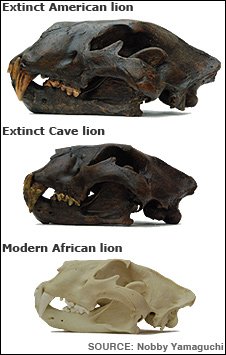
April 2, 2009

BBC News carried an article on March 31, 2009, about a subject of much interest to cryptozoologists, the late survival of ancient lions. We have discussed these fossil members of Felidae here, especially with regard to the American lion, Panthera atrox. As the accepted and acknowledged time window when they lived slowly creeps closer, perhaps someday zoology, with an assist from cryptozoological findings, might be talking more openly about the historical survival of these large felids.
Giant lions were roaming around Britain, Europe and North America up to 13,000 years ago, scientists from Oxford University have found.
Remains of giant cats previously discovered were thought to be a species of jaguar or tiger but after DNA analysis they were proved to be lions.
They were 25% bigger than the species of African lion living today, and had longer legs to chase their prey.
They would have lived in icy tundra with mammoth and sabretooth tigers.It is thought these animals would hunt over longer distances, and their longer legs would help them chase down their prey as opposed to the modern-day species which tends to ambush its victims.
The Oxford team analysed DNA from fossils and other remains gathered from Germany to Siberia, and Alaska to Wyoming.
Lions appear to have been very important to early man with many depictions of them in their cave paintings, as in seen in the pre-historic cave complex at Chauvet in France.
Other archaeological finds in Germany include figurines which are half man, half lion, leading to the theory that lions may even have been worshipped by ancient humans.
The team found that these remains from the Pleistocene Epoch (1.8 million years ago to 10,000 years ago) could be divided into two groups: the American Lion which lived in North America, and the Cave Lion which lived in northern Europe, Russia, Alaska and the Yukon.
These ancient cats would have lived in an environment that was more like an icy tundra and would have shared their habitat with herds of other large animals such as mammoth, woolly rhino, sabre tooth tigers and giant deer.
About 13,000 years ago these species died out in a mass extinction. Figuring out the reason behind this, Dr. [Ross] Barnett said, was one of the last great scientific mysteries.
by Natalie Hancock, BBC News

Alexander and Craterus fighting a lion. Alexander went on two such hunts, the Sidonian lion hunt (in Phoenicia, 332 BC) and the lion hunt in Basista (a.k.a. Bazaira, Sogdiana, in 328/327 BC). Herodotus recorded how Xerxes’ Persian invasion army of 480 BC was attacked by lions while camped on the eastern fringes of Greece and Macedonia. (See Mysterious America for an entire chapter on this.)
Dr. Ross Barnett, who conducted the research at Oxford University’s department of Zoology, said:
These ancient lions were like a super-sized version of today’s lions and, in the Americas, with longer legs adapted for endurance running.
What our genetic evidence shows is that these ancient extinct lions and the lions of today were very closely related. Cave art also suggests that they formed prides, although the males in the pictures would not have had manes and they are depicted very realistically.
There are a couple of different schools of thought. It could have been climate change or something to do with humans.
Humans could have been killing off their prey or killing the lions themselves. The extinction is a big question that remains unresolved. More research and more advanced genetic analysis may help answer it.
Ah, the blog is back, and it’s important that you keep this research going and save the museum…please
About Loren Coleman
Loren Coleman is one of the world’s leading cryptozoologists, some say “the” leading living cryptozoologist. Certainly, he is acknowledged as the current living American researcher and writer who has most popularized cryptozoology in the late 20th and early 21st centuries.
Starting his fieldwork and investigations in 1960, after traveling and trekking extensively in pursuit of cryptozoological mysteries, Coleman began writing to share his experiences in 1969. An honorary member of Ivan T. Sanderson’s Society for the Investigation of the Unexplained in the 1970s, Coleman has been bestowed with similar honorary memberships of the North Idaho College Cryptozoology Club in 1983, and in subsequent years, that of the British Columbia Scientific Cryptozoology Club, CryptoSafari International, and other international organizations. He was also a Life Member and Benefactor of the International Society of Cryptozoology (now-defunct).
Loren Coleman’s daily blog, as a member of the Cryptomundo Team, served as an ongoing avenue of communication for the ever-growing body of cryptozoo news from 2005 through 2013. He returned as an infrequent contributor beginning Halloween week of 2015.
Coleman is the founder in 2003, and current director of the International Cryptozoology Museum in Portland, Maine.
Filed under Alien Big Cats, Breaking News, Cryptotourism, CryptoZoo News, Cryptozoologists, Cryptozoology, Extinct, Fossil Finds, Mystery Cats